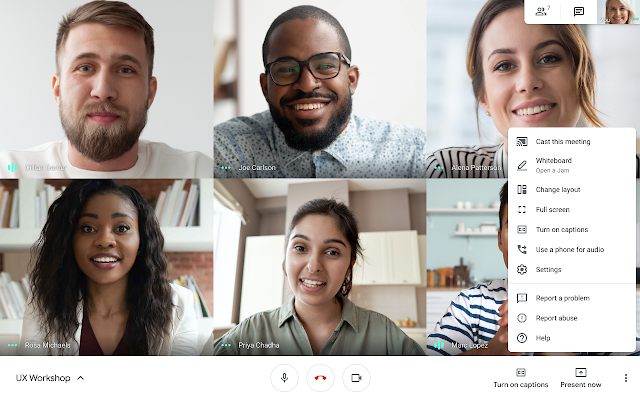What’s changing
In late 2024, we will wind down the Jamboard whiteboarding app as well as continue with the previously planned end of support for Google Jamboard devices. For those who are impacted by this change, we are committed to help you transition:
- We are integrating whiteboard tools such as FigJam, Lucidspark, and Miro across Google Workspace so you can include them when collaborating in Meet, sharing content in Drive, or scheduling in Calendar.
- Further, we’re bringing these whiteboard solutions to the Series One Board 65 and Desk 27 devices by Avocor, so you can visually collaborate using a physical device and stylus.
- We will provide a retention and migration path for Jamboard data so you don’t lose any of the collaborative work that’s been created within your organization.
Admins of impacted Google Workspace customers will receive more detailed information and instructions via email. We’ll continue to provide reminders here on the Updates Blog throughout this process as well.
Who’s impacted
Admins and end users
Why it’s important
We’re committed to partnering with industry-leading companies to bring the most innovative collaboration experiences to Google Workspace. We’ve heard from our customers that whiteboarding tools like FigJam by Figma, Lucidspark by Lucid Software, and the visual workspace Miro help their teams work better together — specifically, the advanced features they offer such as infinite canvas, use case templates, voting, and more. Based on this feedback, we’ve decided to leverage our partner ecosystem for whiteboarding in Workspace and focus our efforts on core content collaboration across Docs, Sheets, and Slides.
Whiteboarding capabilities in the conference room or classroom
Earlier this year, our partner, Avocor, delivered two next-generation video conferencing and whiteboarding devices, the Series One Board 65 and Desk 27, to succeed the original Jamboard device. With built-in Google AI features, studio-grade audio, and seamless video conferencing through Google Meet, these devices are designed for immersive team collaboration.
Today, we’re announcing that FigJam, Lucidspark, and Miro will create integrations for these devices, with expected delivery at the end of 2023 and early 2024 — we’ll keep you posted on the availability here on the Workspace Updates blog. Soon you’ll not only have a choice of three robust third-party whiteboarding experiences inside a Meet call, you’ll also have new options to use them outside a call as standalone whiteboarding tools on the Board 65 and Desk 27.
Transition timeline
Jamboard device:
- All Jamboard device license subscriptions (including education licenses) will end on September 30, 2024. If you have an upcoming 12-month subscription renewal, you will have the ability to renew your license subscription for a term that will end on September 30, 2024, at a prorated cost.
- If you need to back up any Jamboard device event logs from the Admin console, please do so before September 30, 2024. After this date, you will no longer be able to manage Jamboards from the Admin console and we will begin to delete device event log data.
- October 1, 2024, the 55-inch Jamboard device will reach its Auto Update Expiration (AUE) and will no longer receive security and feature updates or customer support from Google Workspace. At this time, we will also remove Jamboard device management from the Admin console, leaving the device with limited functionality. Our FAQ page contains details on how you can continue to use your 55-inch Jamboard device beyond its AUE date.
- Those looking for an alternative to the 55-inch Jamboard device can upgrade to the Google Meet Series One Board 65 and Desk 27 devices by Avocor. Both devices will have integrations with our partners’ whiteboarding software to replace the Jamboard app. We will follow up as we approach the AUE date with reminders and updates.
Jamboard app
- Starting October 1, 2024, you’ll no longer be able to create new or edit existing Jams on any platform, including the web, iOS, and Android.
- Between October 1, 2024, and December 31, 2024, the app will be placed in “view-only” mode, during which time you will still be able to backup your Jam files. Learn more.
- On December 31, 2024, we will wind down the Jamboard application, meaning your users will no longer be able to access their Jam files and Jam files will be permanently deleted. In the coming months, we’ll provide Jamboard app users and admins clear paths to retain their Jamboard data or migrate it to FigJam, Lucidspark, and Miro within just a few clicks, well before the Jamboard app winds down in late 2024. Review how you can generate a list of your Jamboard active users. Also, have your users download their Jam files
Additional details
Getting started
- Admins: Use this article in our Help Center for more Jamboard end of life information.
- End users: You can keep your Jam files in Drive by saving them as PDFs. Learn how to download Jam files.
Availability
- This update impacts all Google Workspace customers who use the Jamboard app or 55-inch Jamboard device.














